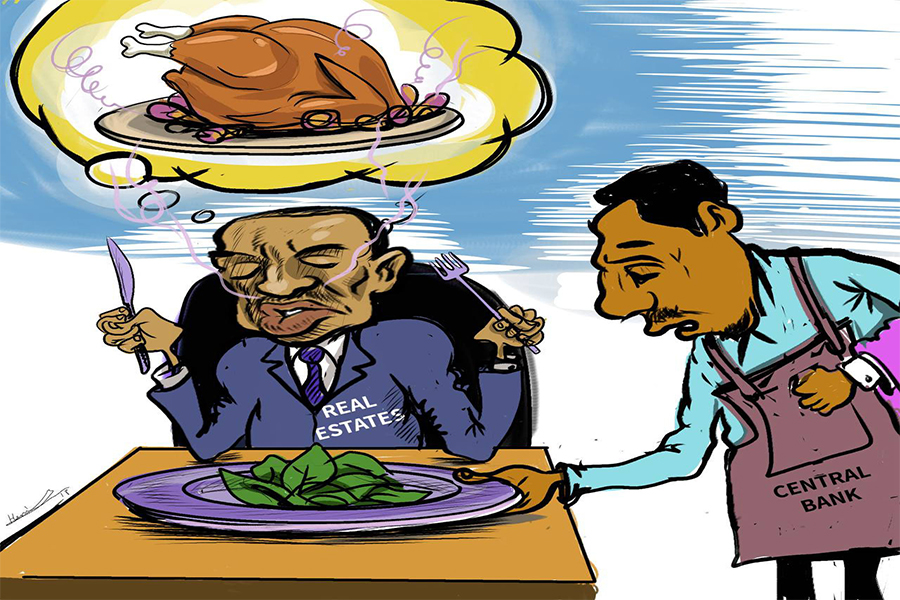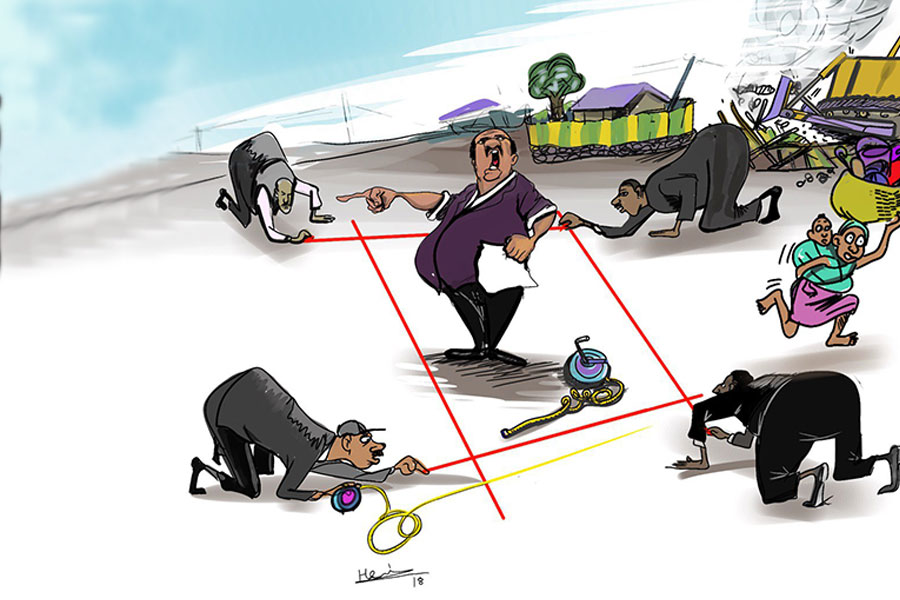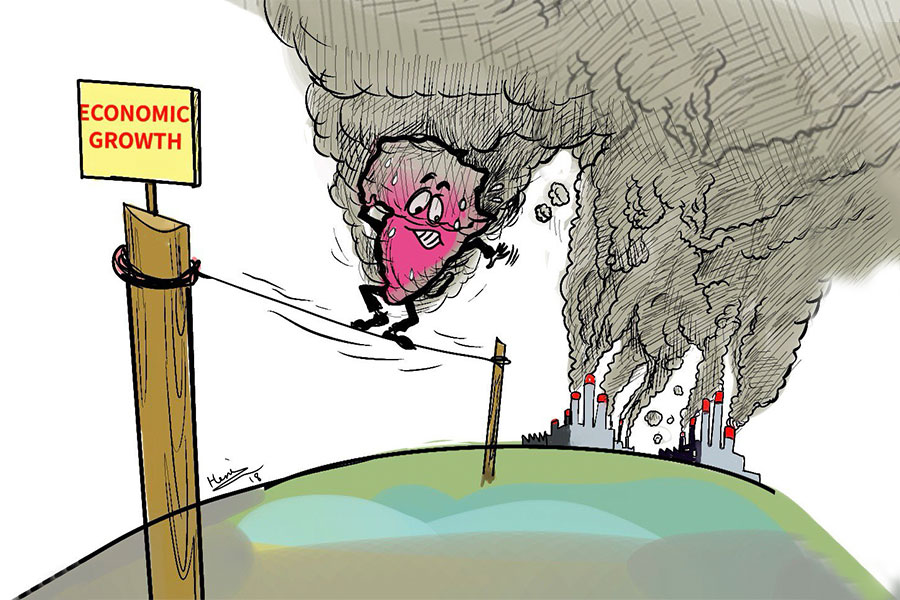The streets of Abo Mazoria around Mekanisa, once bustling with people, now lie in silence. It is now filled with debris and dust. On the morning of December 26, 2024, the area seemed almost unrecognisable; narrow streets that once housed small busy shops and shopping centers are now filled with scrap metal, wood, and broken concrete.
Isuzu and pickup trucks and workers wander through the debris, loading whatever they can salvage.
Yigermal Temesgen, a pickup truck owner, waits by the roadside for a client. His task is to transport metal sheets and wood from the demolished houses. A father of two, with children in grades four and six, Yigermal lives in the Saris area with his parents, who depend on him for support.
His only source of income is his aging Toyota single-cab pickup truck, which he uses to transport goods between Saris and Gottera. The truck can load up to 12 qtls. Before the demolitions, his daily net income averaged 2,000 Br.
Supporting his family was no easy task. Yigermal not only provides for his wife and children but also sends 2,600 Br each month to his brother, a health sciences student at Wolaita Sodo University. His children’s school fees cost 2,700 Br monthly, and he spends another 2,000 Br on his father’s medical expenses. His wife earns a net monthly salary of 5,200 Br.
The corridor development project in Addis Abeba has improved his income. The demolition of neighborhoods has brought new opportunities for Yigermal. Previously, he managed one transport job a day. Now, he averages three trips, earning around 5,000 Br daily, sometimes reaching as high as 9,000 Br.
With increased income, life has changed for his family. “When your income grows, so do your desires,” Yigermal said. He no longer works late into the night searching for jobs. Instead of returning home at 8 PM, he now finishes by 6 PM.
His children’s transportation service, once costing 1,100 Br a month by Isuzu bus, has been upgraded to a 1,850 Br minibus service. His weekly Equb savings also grew from 1,600 Br to 3,000 Br.
Addis Abeba’s corridor development project has affected the freight transport business. The demolition of homes and businesses has triggered soaring demand for trucks to move salvaged materials and household belongings.
The project, launched in March, began with Piassa and expanded in October to cover 132km and 2,817 hectares. Addis Abeba City Mayor Adanech Abiebie announced five billion Birr and 100 hectares set aside for compensation to displaced homeowners.
The corridors, ranging from the 3.1km Anbesa Garage-Jakros-Goro route to the 40.4km Kasanchis-Estifanos-Meskel Square-Mexico-Churchill-Arat Kilo corridor, connect residential, commercial, and recreational areas.
The second phase of the corridor development includes vast areas covering Arat Kilo, Qebena, Piassa, Kazanchis, Mekanisa.
The project has led to displacement in these areas, creating steady work for truck owners as residents relocate. Alongside moving household items, trucks are in high demand to transport debris from demolished sites.
Isuzu NPR trucks and Sinotruks handle heavy loads, with Isuzus carrying around 40qtls and Sinotruks transporting up to 250qtls. Smaller pickups are used for lighter loads.
For many drivers, this boom is a paradox. Abraham Megersa, an Isuzu driver, says business has improved, but he was displaced by the same project. He used to transport goods across the country and now only operates within the city limits due to security issues. "We make more money, but the costs rise just as fast," he said. He attributes this to soaring costs for fuel, spare parts, and taxes. A single Isuzu tire now costs 28,000 Br.
Despite expenses, daily earnings for drivers like Abraham and Yigermal have nearly doubled. Abraham’s income jumped from 4,500 to 8,500 Br, while Yigermal’s rose from 2,000 to 5,000 Br.
Kibrom Hayelom, a Sinotruk driver based in Haile Garment, now earns 13,000 Br daily, up from 8,000 Br, thanks to the rising demand driven by Addis Abeba’s corridor development projects. Many drivers told Fortune that there is an increase in work, with no need to wait in line for jobs.
The surge in demand extends beyond transporting debris and relocations. The overall price for transport services has sharply increased. Kibrom, working over 16 hours daily, ferries sand, soil, and gravel, while others like Tsedalu Teshome deliver drinking water.
Tsedalu, with 11 years of experience, has seen his daily income rise from 5,000 Br a year ago to 8,000 Br by selling 2,000 liters for 1,200 Br.
Increased demand has partly driven up truck prices. Kaki Plc, an importer and assembler of Isuzu trucks for over two decades, says it has seen a 25pc price hike since July. The price of an Isuzu NPR truck has increased from four million to five million Birr, influenced by forex liberalisation as well, according to Muez Yihdego, deputy general manager at Kaki.
However, drivers and truck owners in Addis Abeba are also facing new problems despite booming business from corridor development projects. Restrictions on movement times imposed by the Addis Abeba Transport Bureau and Oromia Regional State limit work hours on main roads. Some drivers also cite safety issues in some areas.
Yonas Aweke, general manager of Selam Le-Andinet Freight Association near Mercato, said that time limits and instability outside the city have reduced opportunities for cargo drivers beyond Addis Abeba. Spare part shortages are another hurdle for truck owners.
While transport operators benefit, customers are paying higher prices. Asnakew Derese, a merchant, says freight costs have risen, 15 Br more per quintal for pickup trucks and 10 Br more for Isuzu trucks compared to three months ago.
For residents like Yohannes Derbie, whose home in Mekanisa was demolished, the cost of moving has been steep. He paid 27,000 Br to transport his furniture and scraps.
Although city authorities promised to cover relocation costs, Yohannes and others found the process very slow and opted to pay themselves.
“I had no choice but to pay; it is hard to afford,” Yohannes said.
Mohammed Abdulaziz, a broker, stated that while transport prices have not spiked drastically, the increased demand has made it easier for drivers to find work.
“Like the drivers, we are also working more,” Mohammed said, noting that most displaced residents are relocating to nearby areas.
PUBLISHED ON
Jan 04,2025 [ VOL
25 , NO
1288]

Dec 22 , 2024 . By TIZITA SHEWAFERAW
Charged with transforming colossal state-owned enterprises into modern and competitiv...

Aug 18 , 2024 . By AKSAH ITALO
Although predictable Yonas Zerihun's job in the ride-hailing service is not immune to...

Jul 28 , 2024 . By TIZITA SHEWAFERAW
Unhabitual, perhaps too many, Samuel Gebreyohannes, 38, used to occasionally enjoy a couple of beers at breakfast. However, he recently swit...

Jul 13 , 2024 . By AKSAH ITALO
Investors who rely on tractors, trucks, and field vehicles for commuting, transporting commodities, and f...

Oct 4 , 2025
Eyob Tekalegn (PhD) had been in the Governor's chair for only weeks when, on Septembe...

Sep 27 , 2025
Four years into an experiment with “shock therapy” in education, the national moo...

Sep 20 , 2025
Getachew Reda's return to the national stage was always going to stir attention. Once...

Sep 13 , 2025
At its launch in Nairobi two years ago, the Africa Climate Summit was billed as the f...